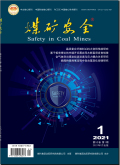煤矿安全2024,Vol.55Issue(2):1-9,9.DOI:10.13347/j.cnki.mkaq.20230344
基于压汞-低温液氮联孔与核磁共振分析的煤中孔径分布对比研究
Comparative study on pore size distribution in coal based on mercury intrusion-low temperature liquid nitrogen combined pore and nuclear magnetic resonance analysis
摘要
Abstract
The pore structure measurement in coal is commonly analyzed by mercury intrusion method,low temperature liquid nitro-gen method and nuclear magnetic resonance method.Due to the different test methods,the results cannot be used uniformly,and the matrix compression effect in mercury intrusion method will cause large errors.In order to solve this problem,three high-rank coal samples from Jincheng and Changzhi Mining Areas in Qinshui Basin were taken as examples,and used mercury injection,low-tem-perature liquid nitrogen adsorption and nuclear magnetic resonance relaxation methods to test the pore structure of coal samples re-spectively.Through the compressibility correction of mercury injection data and splicing with low-temperature liquid nitrogen data at the connection aperture,the pore structure of coal was characterized by joint characterization,and the pore size distribution charac-teristics of coal were compared and analyzed in combination with nuclear magnetic resonance.The results show that the pore volume corrected by mercury intrusion data is closer to that of low temperature liquid nitrogen,and the deviation value is 22.40%-38.51%;the pore structure of different coal samples is analyzed by the joint pore method,and the position of the joint pore is between 75-89 nm;the results show that the pore volume of coal samples is 0.001 36-0.004 58 cm3/g,and the pore volume ratio of different pore sizes is transition pore>macropore>mesopore>micropore;compared with the single test method,the pore size distribution of the combined pore method and the nuclear magnetic resonance method is closer,but there are also differences.The average distribution ratios of micropores,transition pores,mesopores and macropores characterized by the combined pore method are 8.68%,45.58%,20.54%and 25.20%,respectively.The average distribution ratios of micropores,transition pores,mesopores and macropores charac-terized by the nuclear magnetic resonance method are 10.64%,64.21%,14.23%and 10.92%,respectively.The reason for the differ-ence may be mainly related to the pore structure of coal changed by mercury intrusion method and low temperature liquid nitrogen method;through the comparison of NMR results,it is found that the combined corrected mercury injection and low temperature li-quid nitrogen data can improve the accuracy of the pore size distribution test results in coal.关键词
煤孔隙结构/孔径拼接/压汞法/低温液氮吸附法/低场核磁共振驰豫法Key words
coal pore structure/aperture splicing/low temperature liquid nitrogen adsorption method/mercury injection method/low field nuclear magnetic resonance method分类
矿山工程引用本文复制引用
李娜娜,刘会虎,桑树勋..基于压汞-低温液氮联孔与核磁共振分析的煤中孔径分布对比研究[J].煤矿安全,2024,55(2):1-9,9.基金项目
国家自然科学基金资助项目(42277483,41727801) (42277483,41727801)
安徽省自然科学基金资助项目(2008085MD121,2108085MD134) (2008085MD121,2108085MD134)

